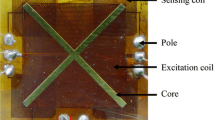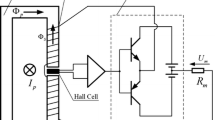Abstract
The output performance of residence times difference (RTD) fluxgate may vary under different driving conditions (driving currents and frequencies) and core materials. To optimize the RTD fluxgate and simplify its design process, an analytical model is employed to select the parameters and identify the effective factors that dominate the performance. The dynamic permeability parameters (P i ), which reflect the changes in the magnetization curve, are mathematically analyzed in detail. The linear variation functions of P i in different driving conditions are fitted by using the dynamic arctangent hysteresis model. Consequently, the selection of driving conditions and core materials, which are assessed by comparing the experiment and simulation results, has an important role in achieving the optimal output performance of the RTD fluxgate.
抽象
创新点
滞留时间差型(RTD)磁通门的输出响应会随着不同的激励条件(激励信号的幅值和频率)和不同的磁芯材料而改变。为了优化RTD型磁通门和简化其设计过程, 本文提出了一种基于选择和确定对其输出响应有主导作用的有效因子的分析模型, 进而详细地讨论能够反映磁化曲线变化的动态磁导率参数(Pi)。在不同的激励条件下, 用动态反正切磁滞模型拟合Pi的线性变化函数, 并通过理论计算与仿真结合的方式得到最优设计参数。最后, 实验和仿真结果的对比表明该方法可以指导激励条件和磁芯材料的选择, 这对于RTD型磁通门输出响应的优化具有很重要的意义。
Similar content being viewed by others
References
Andò B, Baglio S, Bulsara A R, et al. RTD fluxgate: a low power nonlinear device to sense weak magnetic fields. IEEE Instrum Meas Mag, 2005, 8: 64–73
Primdahl F. The fluxgate magnetometer. J Phys E: Sci Instrum, 1979, 12: 241–253
Zhang H G, Wang Y C, Song Z. Absolute stabilization of singular systems with ferromagnetic hysteresis nonlinearity. Sci China Inf Sci, 2013, 56: 078201
Sivasubramanian S, Widom A, Srivastava Y. Equivalent circuit and simulations for the landau-khalatnikov model of ferroelectric hysteresis. IEEE Trans Ultrason Ferroelect Freq Control, 2003, 50: 950–957
Luo W, Liu S. Fitting the curve of magnetic hysteresis loop of ferromagnetic material of fluxgate. Metallic Funct Mater, 2008, 15: 30–32
Ripka P, Butta M, Fan J, et al. Sensitivity and noise of wire-core transverse fluxgate. IEEE Trans Magn, 2010, 46: 654–657
Eyal W, Eugene P. Noise investigation of the orthogonal fluxgate employing alternating direct current bias. J Appl Phys, 2011, 109: 07E529
Héctor T, Juan C, Mairée R, et al. Analysis of the fluxgate response through a simple spice model. Sensor Actuat, 1999, 75: 1–7
Geiler A L, Harris V G, Vittoria C, et al. A quantitative model for the nonlinear response of fluxgate magnetometers. J Appl Phys, 2006, 99: 08B316
Andò B, Baglio S, Bulsara A, et al. RTD fluxgate behavioral model for circuit simulation. In: Proceedings of Eurosensors XXIV Conference. Linz: Elsevier Press, 2010. 1288–1291
Andò B, Baglio S, Bulsara A R, et al. SPICE simulation of coupled core fluxgate magnetometers. In: Proceedings of Instrumentation and Measurement Technology Conference. Binjiang: IEEE Press, 2011. 1–5
Andò B, Baglio S, Bulsara A R, et al. Adaptive modeling of hysteretic magnetometers. IEEE Trans Instrum Meas, 2012, 61: 1361–1367
Andò B, Baglio S, Sacco V, et al. Effects of driving mode and optimal material selection on a residence times difference-based fluxgate magnetometer. IEEE Trans Instrum Meas, 2005, 54: 1366–1373
Yin C, Jia Z, Ma W C, et al. Modeling and analysis of nano-sized GMRs based on Co, NiFe and Ni materials. Sci China Inf Sci, 2014, 57: 022404
Andò B, Ascia A, Baglio S, et al. Towards an optimal readout of a RTD fluxgate magnetometer. Sensor Actuat A Phys, 2008, 142: 73–79
Canepa F, Chirafici S, Napolentano M, et al. Nonlinear effects in the ac magnetic susceptibility of selected magnetic materials. J Alloy Compd, 2007, 442: 142–145
Wang Y, Wu S, Zhou Z, et al. Research on the dynamic hysteresis loop model of the residence times difference (RTD)-fluxgate. Sensors, 2013, 13: 11539–11552
Andò B, Baglio S, Bulsara A R, et al. Investigation on optimal materials selection in RTD-fluxgate design. In: Proceedings of Instrumentation and Measurement Technology Conference. Ottawa: IEEE Press, 2005. 1261–1265
Andò B, Baglio S, Bulsara A R, et al. “Residence times difference” fluxgate magnetometers. IEEE Sensor J, 2005, 5: 895–904
Bulsara A R, Seberino C, Gammaitoni L, et al. Signal detection via residence-time asymmetry in noisy bistable devices. Phys Rev E, 2003, 67: 016120
Andò B, Baglio S, Bulgan A R, et al. A new readout strategy for fluxgate sensor. In: Proceedings of Instrumentation and Measurement Conference. Vail: IEEE Press, 2003. 600–604
Nikitin A, Stocks N G, Bulsara A R. Signal detection via residence times statistics: noise-mediated minimization of the measurement error. Phys Rev E, 2003, 68: 036133
Andò B, Baglio S, Bulsara A R, et al. “Residence times difference” fluxgate. Measurement, 2005, 38: 89–112
Stewart M, Cain M G. Ferroelectric Hysteresis Measurement & Analysis. NPL Report CMMT(A). 1999
Lei C, Wang R, Zhou Y, et al. MEMS micro fluxgate sensors with mutual vertical excitation coils and detection coils. Micro Syst Tech, 2009, 15: 969–972
Chiesi L, Kejik P, Janossy B, et al. Planar 2D micro-fluxgate sensor. Sens Actuat A Phys, 2000, 82: 174–180
Andò B, Baglio S, Pitrone N, et al. Noise effects in RTD fluxgate. IEEE Sensor J, 2005, 4: 935–938
Author information
Authors and Affiliations
Corresponding author
Rights and permissions
About this article
Cite this article
Wang, Y., Wu, S., Lu, H. et al. Output performance optimization for RTD fluxgate sensor based on dynamic permeability. Sci. China Inf. Sci. 59, 112213 (2016). https://doi.org/10.1007/s11432-015-5465-9
Received:
Accepted:
Published:
DOI: https://doi.org/10.1007/s11432-015-5465-9




